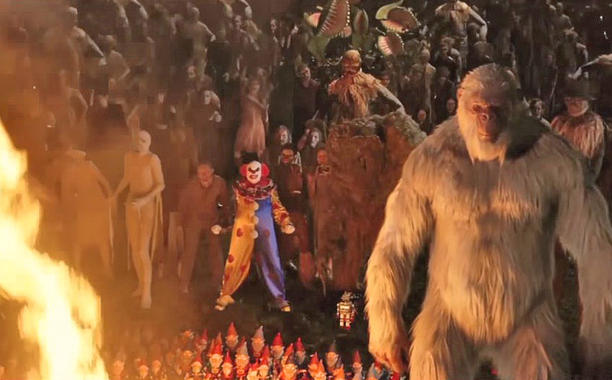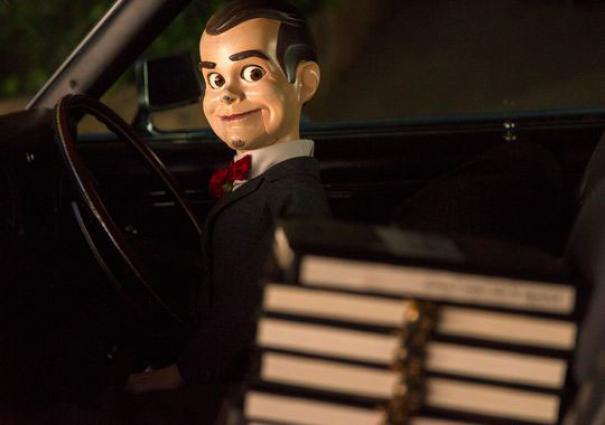Goosebumps has some of my favorite visual effects I’ve seen in years, but it struggles throughout to find its tone. That struggle really hampers the film, preventing it from becoming the best film it could be—which is, I’d argue, a sort of R.L. Stine’s Jumanji.
Full disclosure time: Goosebumps, as a book series, TV show, and occasional made-for-TV movie, was a massive part of my childhood. I’m sure there were multiple months-long stretches where, outside of classwork, I read nothing but Goosebumps, and I was a very avid reader. So when I heard we were getting a theatrical-release Goosebumps movie in which R.L. Stine’s monsters come to life, I was so onboard. Then I was a little confused when the trailer showed Jack Black starring as the author himself. The Stine I knew (granted, only from introductions to episodes of the aforementioned TV show) was quiet and a little wry, in a dad-joke sort of way. I couldn’t envision Jack Black answering that casting call.
That dissonance is emblematic of the problems throughout Goosebumps. Comedic beats, of which there are many, frequently fail to land. Often, the contrast between a situation’s stakes and its comedic moments are not drawn starkly enough. Sometimes, the timing just feels an instant off. The script includes quite a few moments that could have been pretty funny, but they fail to get a laugh, perhaps in part due to director Rob Letterman’s inexperience (here driving his fourth feature-length film, and his second with Black, following up on 2010’s middling Gulliver’s Travels, which allowed considerably more latitude for Black to play within his usual range).
Because of those beats, Goosebumps often seems to want to embrace its sillier side, humanizing its young cast among the absurd events in which they find themselves a part. However, neither our protagonist, Zach (Dylan Minnette, Prisoners), nor our ostensible comic relief, Champ (Ryan Lee, Super 8), seem to feel comfortable pursuing that. Perhaps they are, ironically enough, afraid of breaking the tension the main plot creates. Trying to pursue horror and comedy at the same time is difficult and, it often seems, counterproductive. I do not envy the task of having to portray terror while still milking the audience for ironic laughs while limiting one’s asides to comments that don’t jeopardize a PG rating. While Minnette is a believably aloof teenager, his snark lacks energy. Lee is reasonably frightened and perfectly awkward, but he seems unwilling to display the kind of complete lack of self-awareness that makes Shaggy Rogers, the pop culture ur-example of this character type, so much fun. Again, it’s hard to tell if this is a shortcoming of these young actors, or if the directorial vision, for lack of a better phrase, chickened out on the script’s jokes.
Odeya Rush, who plays Stine’s daughter, Hannah, does a fine job with a character who doesn’t get fleshed out too much, though that may have been intentional, as (highlight for spoilers) she turns out to be a fictional creation of Stine’s, which, from a metatextual perspective, is somewhat infuriating for the only truly interesting female character in the movie.
Goosebumps is not without strengths, though. The creature design, while largely ripped from Stine’s own pages or the TV series, is fantastic, and the monsters are exceedingly well-rendered. When the first creature, the Abominable Snowman of Pasadena, emerges in a gorgeous sequence where typewritten ink liquefies, flows together, and coalesces to form the hulking creature, it sets the stage perfectly for what’s to come. The monsters, including a massive mantis; lush, toothy Venus fly traps; and, of course, the iconic Slappy the Dummy, look real and solid and threatening without jeopardizing the innocence of the PG film’s target audience.

The decision to have Black provide Slappy’s voice in addition to his performance as Stine is incredibly thematically strong. In a movie about Stine’s relationship with the creatures he creates, having his darkest, most personal creation literally be nothing more than him throwing his voice works well. It bolsters Stine’s earlier somewhat awkwardly provided confession that he first started writing about monsters when he was young because he wanted them to attack the other children in his neighborhood. Black/Stine-as-Slappy opens the door for an interesting exploration of art-as-psychoanalysis, in a sort of “he who writes monsters should see to it that he himself does not become one” type of way. This angle is, perhaps wisely, largely cast aside in favor of monster mayhem, and the amount of screen time it’s given gets the job done insofar as a Goosebumps movie needs it to.
The choice to not press the gas a bit on that depth, though, combines with the often-flat humor to cut into Goosebumps’ appeal for the twentysomething nostalgia crowd. Frankly, I wanted to see more moments like the one where R.L. Stine the character, as portrayed by Jack Black, briefly greets R.L. Stine, the man, as “Mr. Black,” the new drama teacher, near the end of the movie. At another point, Stine rants that he’s sold more books than Stephen King (which is actually true), but no one talks about it. Those little unobtrusive nods to the world beyond the movie are what makes this type of kid-friendly franchise revival enjoyable both for first-generation fans and the younger ones they’ve taken to the movies. That being said, I’d certainly recommend Goosebumps once it comes to Redbox or Netflix for friends who remember the franchise fondly and are looking for something to watch with younger relatives—just don’t expect to be blown away, except perhaps by the monsters, or the youngsters’ reactions to them.
Goosebumps is now playing in theaters everywhere.


